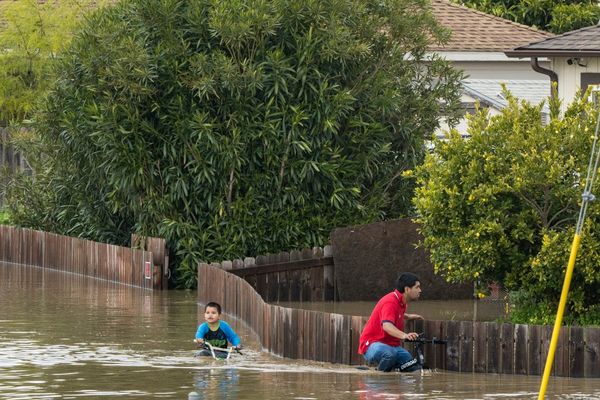WATSONVILLE, Calif. — Officials have known for decades that the Pajaro River levee that failed this weekend — flooding an entire migrant town and trapping scores of residents — was vulnerable but never prioritized repairs in part because they believed it did not make financial sense to protect the low-income area, interviews and records show.
“It was pretty much recognized by the early ‘60s that the levees were probably not adequate for the water that that system gets,” Edwin Townsley, U.S. Army Corps of Engineer’s Deputy District Engineer for Project Management for the San Francisco region, told the Los Angeles Times on Sunday.
And despite having studied it on and off for years, in terms of “benefit-cost ratios,” it never penciled out, he said.
“It’s a low-income area. It’s largely farmworkers that live in the town of Pajaro,” Townsley said. “Therefore, you get basically Bay Area construction costs but the value of property isn’t all that high.”
The levee was built in 1949 and, according to a 2021 Army Corps webpage summary of the system, “no longer provides the designed level of protection.”
Flooding has occurred five times since it was completed, including a breaching event in 1995 in which two people drowned and economic damage was estimated to range between $50 million and $95 million. Flooding occurred again in 1997, and in 1998 President Clinton issued a disaster declaration. More recently, there was a near-flooding event in 2017 and again this past January.
But three years ago, “as part of the overall environmental justice resetting of the federal government Corps of Engineers, OMB, Congress, all recognized that if you exclusively looked at benefit-cost ratios you wouldn’t fund projects in areas that were typically lower-income,” Townsley said.
So the Corps initiated a study that resulted in a report demonstrating “there would be some value for life safety, even though the project benefit-cost ratio was pretty close to unity for the costs to equal the benefits,” he said.
And they’re currently designing a system that they were hoping to move into construction in the next two years, he said, funded by the Infrastructure Jobs Act and state money — secured by a 2021 bill that directed the Department of Water Resources to pay 100% of the state’s cost for reconstruction of the Pajaro/Watsonville levee system.
“It’s tragic that we got this just before we’re starting construction,” he said, referring to the breach and flooding.
“Low-income neighborhoods and communities have always historically been ignored by state and federal governments,” said Monterey County Supervisor Luis Alejo. “The story of Pajaro is exactly that. There was a lack of commitment by our federal and state governments. The residents have never felt they had that kind of support, knowing that the danger, the risk, has always been there.”
Farshid Vahedifard, a professor of civil and environmental engineering at Mississippi State University, said communities living near levees are often underserved or economically disadvantaged.
City, local and state governments “have a historic, you know, a long track record of discrimination when it comes to levees. They are a good example of infrastructure equity issues that we have been dealing with for decades,” he said.
In a recent paper, Vahedifard noted that inland floods had caused 624 fatalities in the U.S. and $164 billion in damages “that disproportionately affect disadvantaged communities.”
Pajaro is in unincorporated Monterey County, and despite being in a different county than and across the river from Watsonville, the two communities share a ZIP Code. Pajaro does not have its own post office.
According to Alfredo Torres, a Watsonville resident who grew up in Pajaro, the smaller Monterey County town is considered the backwater of the area.
“It doesn’t have the urban amenities of Watsonville,” he said, and because it’s in an unincorporated area, public services — such as law enforcement — are pretty minimal.
Watsonville’s population is close to 53,000; Pajaro’s is roughly 3,000.
On Saturday, most of the Pajaro evacuees at the Santa Cruz County Fairgrounds were primarily Spanish-speaking. Andres Garcia, a Pajaro resident, said many are migrant farmworkers who work in the nearby strawberry farms.
According to county officials, the state is trying to plug the breach — which has grown to 120 feet — with granite boulders.
But that comes with risks, Townsley said.
“This next wave (of weather) coming in is going to put additional pressure on the system and so you’re in this weird spot where the breach actually reduces pressure on the Watsonville side,” he said. “Once again, the lowest-income community is now bearing the brunt ... .
“The last time there was a flood through here was in ‘95, and there was talk then of doing things” to address the levee, said Glenn Church, a member of the Monterey County Board of Supervisors. He sighed. “Government moves sometimes kind of slow.
“It would have been great if all this could have been done sooner,” Church said. “But I’m just glad to see that there’s finally some permanent solutions being put in place for dealing with this, so we don’t have to deal with this every 10 or 20 years.”
———
(Los Angeles Times staff writer Emily Alpert-Reyes contributed to this report.)










